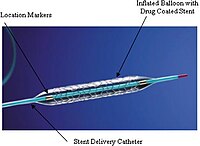
Photo from wikipedia
BACKGROUND Risk assessment and treatment stratification for three-vessel coronary disease (TVD) remain challenging. This study aimed to investigate the prognostic value of left atrial volume index (LAVI) with the Synergy… Click to show full abstract
BACKGROUND Risk assessment and treatment stratification for three-vessel coronary disease (TVD) remain challenging. This study aimed to investigate the prognostic value of left atrial volume index (LAVI) with the Synergy Between Percutaneous Coronary Intervention with Taxus and Cardiac Surgery (SYNTAX) score II, and its association with the long-term prognosis after three strategies (percutaneous coronary intervention [PCI], coronary artery bypass grafting [CABG], and medical therapy [MT]) in patients with TVD. METHODS This study was a post hoc analysis of a large, prospective cohort of patients with TVD in China, that aimed to determine the long-term outcomes after PCI, CABG, or optimal MT alone. A total of 8943 patients with TVD were consecutively enrolled between 2004 and 2011 at Fuwai Hospital. A total of 7818 patients with available baseline LAVI data were included in the study. Baseline, procedural, and follow-up data were collected. The primary endpoint was major adverse cardiac and cerebrovascular events (MACCE), which was a composite of all-cause death, myocardial infarction (MI), and stroke. Secondary endpoints included all-cause death, cardiac death, MI, revascularization, and stroke. Long-term outcomes were evaluated among LAVI quartile groups. RESULTS During a median follow-up of 6.6 years, a higher LAVI was strongly associated with increased risk of MACCE (Q3: hazard ratio [HR] 1.20, 95% confidence interval [CI] 1.06-1.37, P = 0.005; Q4: HR 1.85, 95%CI 1.64-2.09, P <0.001), all-cause death (Q3: HR 1.41, 95% CI 1.17-1.69, P <0.001; Q4: HR 2.54, 95%CI 2.16-3.00, P <0.001), and cardiac death (Q3: HR 1.81, 95% CI 1.39-2.37, P <0.001; Q4: HR 3.47, 95%CI 2.71-4.43, P <0.001). Moreover, LAVI significantly improved discrimination and reclassification of the SYNTAX score II. Notably, there was a significant interaction between LAVI quartiles and treatment strategies for MACCE. CABG was associated with lower risk of MACCE than MT alone, regardless of LAVI quartiles. Among patients in the fourth quartile, PCI was associated with significantly increased risk of cardiac death compared with CABG (HR: 5.25, 95% CI: 1.97-14.03, P = 0.001). CONCLUSIONS LAVI is a potential index for risk stratification and therapeutic decision-making in patients with three-vessel coronary disease. CABG is associated with improved long-term outcomes compared with MT alone, regardless of LAVI quartiles. When LAVI is severely elevated, PCI is associated with higher risk of cardiac death than CABG.
Journal Title: Chinese medical journal
Year Published: 2023
Link to full text (if available)
Share on Social Media: Sign Up to like & get
recommendations!